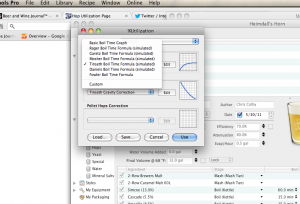When you use a recipe calculator — either a software package such as ProMash, BeerTools, BeerSmith, StrangeBrew or QBrew or any of a number of online recipe calculators — it uses a hop utilization curve to calculate how many IBUs result from boiling x units of hops (at y% alpha acids) for z minutes. For example, if you boiled one ounce of Cascade hops (at 7% alpha acids) for 1 minutes, you’d get one number. If you boiled that same ounce of hops for 15 minutes, you’d get a larger number. If you plotted these numbers from 0 minutes to, say, 90 minutes in 1-minute increments, you’d have a hop utilization curve for 1 ounce of hops at 7% alpha acids. Each recipe calculator either has a proprietary hop utilization curve, or allows you to select among some known curves. These go by names such as Tinseth, Garetz, Mosher, Rager, etc., named for the person who constructed the curve. Some software packages additionally let you select a curve to compensate for the boil gravity (as hop utilization decreases as wort density increases). Many homebrewers, when confronted with the variety of options ask a simple question — which curve is the most accurate?
The answer to this question may not seem very satisfying at first. The answer is that the question is nonsensical. However, once you understand why the question literally cannot be answered as phrased, you’ll know enough about hop utilization curves to select one (or to construct your own).
Accuracy
Accuracy is the ability of a measuring device or predictive tool to measure or predict the true value of a variable. For example, if you had a 1.00-lb. weight and two scales, the more accurate scale would be the one that returned a value closest to 1.00 lbs. If one scale measured 0.98 lbs. and the other measured 1.04 lbs., the first would be the more accurate of the two. (We’ll skip for now how you know the true weight of an object. And for you science nuts out there, we’ll just assume the scales were both precise to plus or minus 0.001 pounds, so a single measurement of the 1.00-lb. weight would be enough to reveal which was more accurate.)
Reality
The reason that any of the hop utilization curves cannot be claimed to be most accurate is that the actual amount of IBUs produced by boiling x units of hops (at y% alpha acids) for z minutes is going to vary among breweries. If two breweries, for example, boiled 1.5 ounces of Centennial hops for 60 minutes in the same volume of wort (at the same original gravity), there is no guarantee that they would both yield the same level of IBUs. Differences in wort boiling temperature (which varies with altitude and atmospheric pressure), boil vigor/evaporation rate, wort pH and other variables specific to each brewhouse will play a role. It is possible for one hop curve — let’s say Tinseth — to be highly accurate for one brewery, but for another brewery, the Garetz curve yields better predictions.
What’s Best for My Homebrewery?
So the real question becomes which curve is right for my home brewery? To really answer that question, you would need to brew several beers, at a variety of bitterness levels and send them off to a lab to have their IBU levels measured analytically. Then, you would compare the real IBUs to the predictions of each curve and see which one was most accurate for you (or better yet construct your own curve based on the data). Almost nobody does this, however.
What most advanced homebrewers do is use one arbitrary-chosen hop curve for their IBU predictions and stick with it. They get to know how bitter a beer will be if their chosen curve estimates the beer to be, say, 40 IBUs and adjust their hopping based on comparisons to other beers with known IBU levels. (Keep in mind, though, that many brewpubs and small craft breweries don’t actually measure their IBUs. The number on their website may just be an estimate, not a measurement.) If the curve you choose seems to give consistently high or low values, based on how you perceive your beer, pick another curve. The point is, in the absence of knowing how accurate a curve is in an absolute sense, you’ll get to know what the IBU numbers translate to in your experience. And if that’s too loosey-goosey for you, type “beer analysis” into Google and get your beer analyzed.


Speak Your Mind